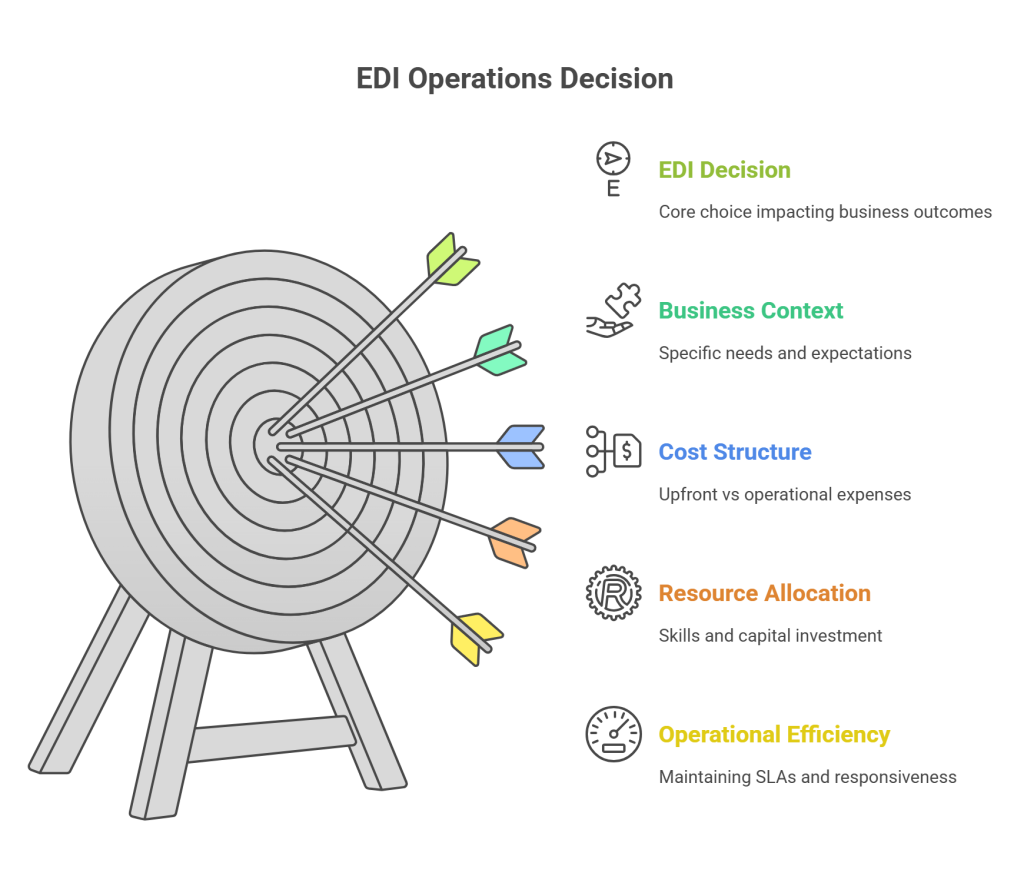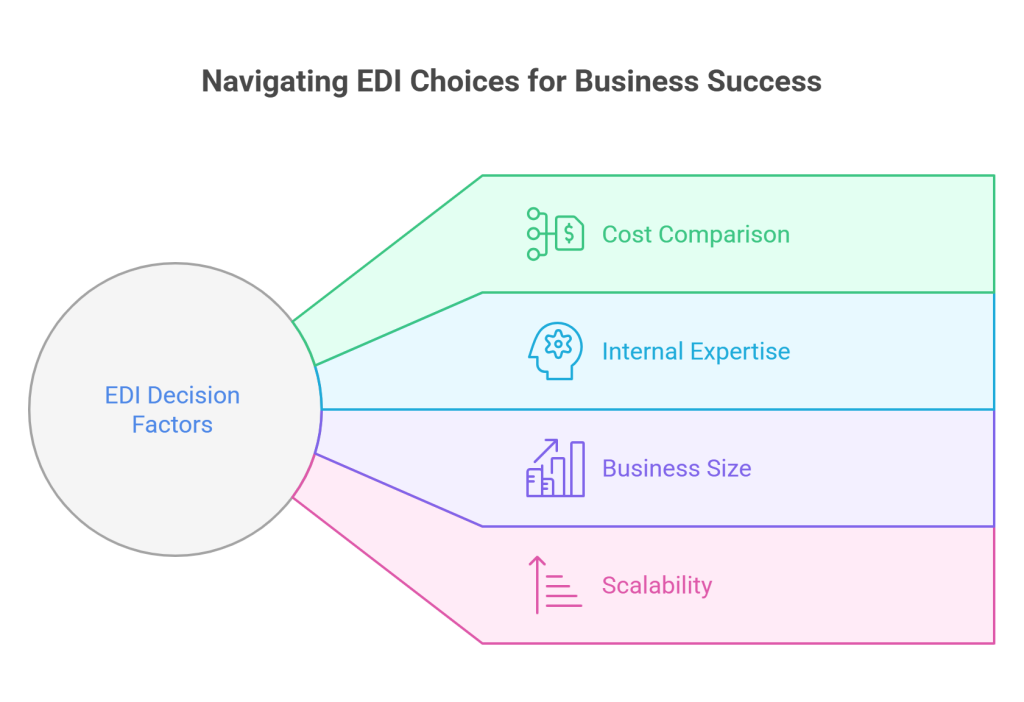Introduction
EDI operations are becoming increasingly critical for modern businesses, yet most companies struggle with whether to manage them in-house or outsource them to specialists. The EDI industry is predicted to reach USD 5 billion by 2032, underlining just how essential these systems have become for business data exchange.
When evaluating your EDI strategy, you’re essentially choosing between building internal infrastructure or leveraging third-party expertise. EDI outsourcing is more appealing than outsourcing in other areas of IT, where it has long been accepted. This is primarily because outsourcing EDI can reduce the cost of investing in your infrastructure while ensuring access to specialized skills and support.
However, this decision isn’t straightforward. Modern business operations typically don’t allow the time or resources needed to build and maintain the expertise required for managing trading partner agreements and requirements in-house. Additionally, by working with managed EDI service providers, companies can reduce the burden on internal IT resources while ensuring accurate and timely data exchange.
Key Takeaways
- In-house EDI offers complete control and customization requires substantial upfront investments in infrastructure, specialized staff, and ongoing maintenance costs.
- Outsourced EDI reduces IT costs by 30% or more while providing access to specialized expertise and faster trading partner onboarding without technical overhead.
- Your decision should align with transaction volume and company size– smaller businesses typically benefit from a cloud-based EDI solution, while larger enterprises may prefer an integrated EDI solution with in-house control.
- Consider scalability and resource availability carefully– outsourced solutions scale without additional investments, while in-house systems require significant resources for expansion.
- This choice isn’t permanent– many companies start with outsourced solutions and transition to hybrid or in-house models as their needs and capabilities evolve.
Understanding EDI Operations: In-House vs Outsourced
Before making the crucial EDI operations decision, companies must thoroughly understand both in-house and outsourced approaches. Let’s break down what each option truly entails and why this choice significantly impacts your business outcomes.

What is In-House EDI?
In-house EDI refers to managing Electronic Data Interchange processes internally using your organization’s infrastructure and personnel. This approach requires allocating physical space for EDI infrastructure, including servers, mapping and translation tools, data integration solutions, and communication services. With in-house EDI, your company assumes full responsibility for setting up and maintaining the EDI system, handling data translation, and providing necessary employee training.
Companies choose this route primarily for greater control over their EDI processes. In-house EDI gives businesses complete governance over when actions are performed, rather than waiting for third parties to complete tasks on their schedule. Furthermore, this approach provides the highest level of insight and visibility into EDI performance, allowing better monitoring and management of technology and processes.
What is Outsourced EDI?
Outsourced EDI (also called managed services) involves hiring a third-party company to set up and manage your EDI technology for communicating data with trading partners. Under this arrangement, specialized service providers handle the technical aspects of EDI, including system setup and maintenance, data translation, communication, mapping, and ongoing changes to EDI specifications.
This option allows companies to take advantage of EDI benefits without investing in and managing the technical infrastructure themselves. Consequently, businesses can focus on core activities while leveraging the provider’s specialized expertise and infrastructure.
Why this Decision Matters for Your Business
The choice between in-house and outsourced EDI is a critical decision that almost every company faces, regardless of size. This decision directly impacts:
- Reputation and customer relationships – EDI outsourcing is a critical relationship with a direct impact on your customers and reputation
- Operational efficiency – Maintaining Service Level Agreements (SLAs) with customers is vital to staying in business
- Resource allocation – Implementation requires access to a broad range of skills and capital investment
- Cost structure – The approach determines whether costs are primarily upfront (in-house) or operational (outsourced)
Moreover, this decision affects how quickly you can respond to trading partner requests and your ability to scale EDI capabilities as business needs evolve. Ultimately, the right choice depends on your specific business context, including company size, trading partner expectations, and how EDI functions as a differentiator in your industry.
Pros and Cons of In-House EDI
Managing your own EDI system comes with significant tradeoffs that demand careful evaluation. The decision to keep EDI operations in-house affects everything from technical infrastructure to staffing requirements. Let’s explore the key advantages and limitations of this approach.

Pros of In-House EDI
Cons of In-House EDI
Full Control
The primary advantage of in-house EDI lies in the complete control it offers over your data exchange ecosystem. Your organization gains total governance over when actions are performed instead of waiting for third parties to complete tasks on their timeline. This arrangement provides the highest level of insight into EDI processes, allowing better monitoring and analysis of performance metrics.
Customization
In-house solutions enable businesses to tailor their EDI system to meet specific requirements and integrate seamlessly with existing infrastructure. This customization capability lets companies quickly adapt to changes and modify EDI processes as business needs evolve. Complete visibility into data processes, security protocols, and adherence to industry standards becomes possible with internally managed systems.
Higher Upfront Costs and Staffing Needs
Despite its benefits, implementing an in-house EDI system typically requires substantial initial investments in hardware, software licenses, and personnel. These expenses can be prohibitive, particularly for smaller or budget-constrained companies. Also, organizations must dedicate resources to software, Infrastructure, and maintenance
Scalability and Maintenance Challenges
Scaling an in-house EDI system often proves complex and time-consuming. As transaction volumes increase with business growth, manual processes become increasingly error-prone. The company bears complete responsibility for maintenance, which can be burdensome. Your internal team must constantly monitor the system to ensure it remains functional and compliant as industry standards change.
Pros and Cons of Outsourced EDI Services
Outsourcing EDI operations has become increasingly attractive for companies seeking specialized expertise without technical overhead. Let’s examine what this approach offers businesses of all sizes.

Pros of Outsourced EDI Services
Cons of Outsourced EDI Services
Access to EDI Managed Service Providers
Outsourced EDI connects you with specialists who handle every aspect of your EDI ecosystem. These providers employ teams of experienced EDI professionals well-versed in technical complexities, mapping, data transformation, and partner onboarding. Unlike vendors that merely sell software, managed service providers (MSPs) deliver comprehensive solutions, including ongoing monitoring and support. Their expertise helps ensure successful data flow with trading partners while minimizing errors.
Lower Infrastructure Costs and Faster Onboarding
Companies choosing outsourced EDI can avoid substantial upfront investments in hardware, software licenses, and specialized personnel. Outsourcing EDI can reduce IT costs by 30% or more. This approach transforms capital expenses into operational costs while leveraging economies of scale. Commport Communications offers a wide range of EDI solutions suitable for all business sizes.
Potential Loss of Control and Vendor Dependency
The primary drawback of outsourced EDI involves relinquishing direct control over your data exchange infrastructure. Organizations must rely on providers to handle issues, potentially affecting responsiveness. This dependency creates challenges if you decide to switch vendors, as transitions can be cumbersome and expensive. Furthermore, outsourcing might limit customization options depending on the provider’s capabilities.
Security and Compliance Considerations
Sharing sensitive data with external providers raises legitimate security concerns. Yet reputable EDI service providers typically implement robust security measures, including encryption, intrusion detection, and frequent backups. For regulated industries, outsourced providers can help ensure compliance with stringent requirements like GDPR and HIPAA. Selecting a provider with proven security credentials is essential for safe information exchange.
How to Choose: Key Factors to Consider
Deciding whether to keep your EDI operations in-house or outsource requires careful evaluation of several critical factors. The right choice ultimately depends on your specific business context and strategic priorities.

1. Cost Comparison: Short-Term vs Long-Term
Initially, in-house EDI demands higher upfront investments in hardware, software, and personnel. Conversely, outsourced EDI typically involves lower infrastructure costs since providers handle the technical aspects. Worth noting, outsourcing can reduce IT costs by approximately 30%.
Beyond immediate expenses, consider the total cost of ownership, including implementation, training, maintenance, and potential scaling costs. For businesses with low transaction volumes, web-based solutions may provide cost-effective entry points.
2. Internal Expertise and Resource Availability
Successfully implementing in-house EDI requires dedicated resources—including IT infrastructure, software, and skilled personnel. First, honestly assess whether your company has sufficient time and IT resources to make EDI a useful part of daily operations.
EDI specialists with the skills to translate business needs into specific solutions are increasingly scarce. Choose a trusted EDI service provider like Commport Communications, trusted by 6000+ brands, with over 40+ years of industry experience. Our EDI consultant can understand your business needs and can help bridge this expertise gap.
3. Business Size and Transaction Volume
Your transaction volume substantially impacts which EDI solution best fits your needs. Throughout your decision process, evaluate whether your company has high or low monthly EDI transaction volumes, as many outsourced services use transaction-based pricing.
Smaller organizations typically benefit from cloud-based solutions that minimize upfront investments while providing necessary functionality.
4. Need for Flexibility and Scalability
Scalability remains a crucial factor for any EDI system. Without proper scalability, organizations risk bottlenecks, system failures, and increased processing times.
As businesses grow, so does their data exchange volume. Hence, a scalable EDI system must accommodate this growth without requiring complete overhauls. Notably, while in-house solutions often require additional investments when scaling up, outsourcing solutions usually do not.
Conclusion
Choosing between in-house and outsourced EDI operations represents a strategic decision that affects your entire business infrastructure. After examining both options thoroughly, we can see that each path offers distinct advantages depending on your specific circumstances.
Companies prioritizing complete control and deep customization might find in-house EDI more suitable, albeit with higher upfront investments and ongoing maintenance responsibilities. Alternatively, businesses seeking cost efficiency and specialized expertise without technical overhead often benefit from outsourced solutions.
Your decision should ultimately align with your organization’s size, transaction volume, available expertise, and long-term growth strategy.
Commport EDI Solutions - #1 Choice For Businesses
Need Help? Download: EDI Buyers Guide
Unlock the full potential of your supply chain with our comprehensive EDI Buyer's Guide — your first step towards seamless, efficient, and error-free transactions
Frequently Asked Questions
In-house EDI offers full control and customization but requires significant upfront investments and ongoing maintenance. Outsourced EDI provides access to specialized expertise and lower infrastructure costs but may result in some loss of direct control.
Outsourcing EDI can be particularly beneficial for smaller businesses as it reduces upfront costs, provides access to specialized expertise, and offers scalable solutions without requiring significant internal resources or technical overhead.
Key factors include cost comparison (short-term vs. long-term), internal expertise and resource availability, business size and transaction volume, and the need for flexibility and scalability in your EDI operations.
Yes, companies can transition between in-house and outsourced EDI operations as their needs evolve. Many start with outsourced solutions during growth phases and later move to hybrid or in-house models, while others shift from in-house to outsourced to reduce complexity.
Outsourcing EDI can significantly reduce IT costs, with estimates suggesting savings of 30% or more. This is primarily due to lower infrastructure costs, access to specialized expertise, and the ability to leverage economies of scale provided by EDI service providers.





